|
FAQs about Marine Snail
Identification 23
Related Articles: Gastropods, Sea Slugs, Mollusks, Abalone,
Related FAQs: Snail ID
1, Snail ID 2, Snail ID 3, Snail
ID 4, Snail ID 5, Snail ID 6, Snail
ID 7, Snail ID 8, Snail ID 9, Snail ID
10, Snail ID 11, Snail ID 12, Snail
ID 13, Snail ID 14, Snail ID 15, Snail ID
16, Snail ID 17, Snail ID 18, Snail ID
19, Snail ID 20, Snail ID 21, Snail
ID 22, Snail ID 24, Snail ID 25, Snail
ID 26, & Marine Snails 1,
Marine Snails 2, Marine Snails 3, Invertebrate ID, Snail Behavior, Snail Selection, Snail Compatibility, Snail Systems, Snail Feeding, Snail Disease, Snail Reproduction, Mollusks, Sea
Slugs, Abalone,
|
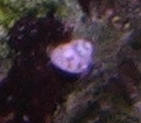
|
|
Mollusk ID: It's The Incredible Mr. Limpet! --
1/21/10
Hi.
<Hello Beth, Lynn here today.>
I was wondering if you could help me figure out what this is.
<Fire away>
I have a 29 g tank that has been running for about 4 years. While
I was doing a water change, I noticed this little guy on a conch
shell (by the way my gold striped clown insists that the conch is
his anemone).
<That's a clown for you!>
I was hoping you could tell me what this is.
<It's a pretty little Keyhole Limpet, family
Fissurellidae. There are other similarly shaped Mollusks, but the
hole at the apex/top is the clincher. This opening, which is used
for expelling waste, can vary from round to distinctly keyhole
shaped, hence the name. Also typical is the arrangement of
concentric growth rings (often showing as different colors),
along with the strong radiating ribs/ridges that extend from the
shell's top/opening to the bottom edge. The almost rough
surface can sometimes be obscured by a growth of algae (usually
green or coralline), but doesn't harm the animal. The
feathery-looking protrusions you see on the soft tissue mantle
skirting the shell are called 'mantle tentacles', and are
sensory in nature. These neat little creatures are for the most
part harmless/beneficial herbivorous grazers but if the food
supply runs low, they can occasionally move on to soft corals or
large polyped stony corals. For example, I had Keyhole Limpets
for years in my tanks with no problems until one large individual
decided to munch on my favorite cherry red Blastomussa wellsi
polyps -- Aaahh! Needless to say, he was ejected from the
display! That's the one and only problem I've ever had
with Keyhole Limpets. Personally, I'd leave your little
individual in place and enjoy it. For more information, please
see the many WWM FAQ's regarding. Just Google the term
Keyhole Limpet: http://www.wetwebmedia.com/Googlesearch.htm
Thanks so much for you help,
<You're very welcome. Enjoy Mr. Limpet!>
Beth Van Zandt
<Take care, LynnZ>
|
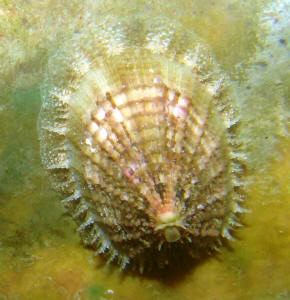 |
|
Marine Snails Identification -- 1/19/10
Hi WWM Crew,
<Hi there, Rafy, Lynn here today.>
I know I have been telling this many times, but this great site
never stop impress me :) Keep up the good work, guys.
<Thanks, it's always a pleasure.>
The reason I am writing this time is to get your help to identify
3 of my snails, which I first thought all of them are Nassarius,
not until I came across a guy at the LFS who told that this snail
is actually damaging towards my corals.
<Which snail? Have you noticed any damage and if so, what type
of coral?>
I may have oversimplified it by thinking all snails with
"antenna" are Nassarius
<Yes, but it's understandable. Not everyone is, or even
wants to be, a snail geek like me!>
..but after hearing that remark at the LFS, I start to feel
uncomfy.
<I can certainly understand that.>
Appreciate your help to verify whether these snails in the
pictures are Nassarius or otherwise.
<I don't think they're Nassarius spp. snails.>
If they aren't Nassarius, then, what are they?
<Heheeee! Would you like the short answer or the long one? How
about both? The short version is that I personally don't
think any of these three snails are harmless herbivores so
I'd remove/relocate them all. Now, here comes the long
version where things get a bit sticky. First of all, I'm
sorry, but I can't see enough detail in the photos, and
don't have enough information (size/location of origin,
etc.), to give a positive ID. However, I can offer some
possibilities for you to research on your own. If you haven't
seen any coral damage, the snails could easily be relatives of
Nassarius spp. snails (Family: Nassariidae). That is, they're
in the same Superfamily: Buccinoidea, which also includes Whelks
(Family Buccinidae), Tulip snails (Family Fasciolariidae), Dove
snails (Family Columbellidae), etc. (see below for links).
I'm leaning towards the Whelks. Snails in this Superfamily
are mostly predators of other snails, bivalves, Polychaetes, and
even Sipunculans ('peanut' worms). They also scavenge and
some have been reported to eat detritus. Others, like some of the
Dove snails, dine on film algae and possibly diatoms. The second
possibility, and large group of snails, includes the predatory
Murex snails (Superfamily: Muricoidea). There are many species
within this group that eat corals, so if you've seen any
damage, it's possible that at least one of your snails
belongs to one of the following families: Muricidae
Coralliophilinae, Muricidae Rapaninae, or even Muricidae
Ergalataxinae (see below for links). One thing to bear in mind
while comparing snails to the photos is that there can be a
surprising amount of variation in color and shape within even a
single specie, so be sure to see all examples. Finally, please
know that I would be more than happy to help you with these
ID's, but I'd just need a bit more information. Anything
you can tell me about origin, or size would be helpful, but most
importantly, I'd need some good detailed photos that include
at least one taken from above each snail, and one from the
flipside, showing the opening/aperture side.
Superfamily Buccinoidea. Go through the various families listed
above (include subfamilies). See the links to thumbnails on the
right side of the following link:
http://www.gastropods.com/Taxon_pages/SuperFamily_BUCCINOIDEA.shtml
See especially: Buccinidae Pisaniinae:
http://www.gastropods.com/Taxon_pages/TN_Family_BUCCINIDAE_PISANIINAE.shtml
Superfamily Muricoidea:
Muricidae Coralliophilinae:
http://www.gastropods.com/Taxon_pages/TN_Family_MURICIDAE_CORALLIOPHILINAE.shtml
Muricidae Ergalataxinae:
http://www.gastropods.com/Taxon_pages/TN_Family_MURICIDAE_ERGALATAXINAE.shtml
Ergalatax margariticola (this species has been noted as a
corallivore): http://www.gastropods.com/1/Shell_1131.shtml
Muricidae Rapaninae:
http://www.gastropods.com/Taxon_pages/TN_Family_MURICIDAE_RAPANINAE.shtml
>
Are they harmful to my reef tank in any way?
<Again, if it were me, I'd remove/relocate them.>
I have provided 2 shots of each of the 3 snails to give you a
look at them from various angles.
<Thanks>
Appreciate it guys :)
<You're very welcome. Please let me know if I can be of
any further assistance.>
RAFY
<Take care, LynnZ>
|
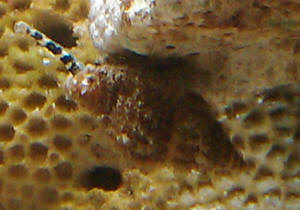 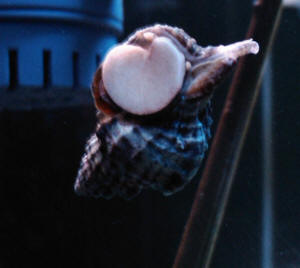
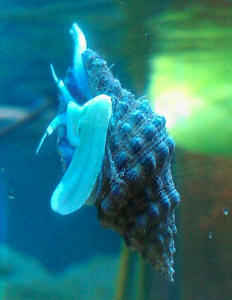 |
|
Baby snails...or something else? Probably something
else. 1-17-10
I've noticed these little snails in my tank a few months ago.
They were very small, just a tiny white dot. Now that they got to
an acceptable size I want to know if you could help me identify
them. <I can try!> I have a few Astrea snails in my tank
and Nassarius Tonga and Vibex. These little snails spend all
their time on the glass and don't hide during the day. What
worries me is that it started with 3 and now I have at least 25.
They don't seem to be bothering anything but I want to make sure
they are safe. I included a pic I hope it is clear enough.
<Unfortunately, no.> The biggest one I noticed the other
day is probably 1/4 inch. Hope you can help. Thank you very
much.( I read all the articles but could not find any positive
ID). <I'm assuming your attached photo shows the underside
of the animal attached to the glass. It doesn't look to be a
snail at all. My best guess points to most likely a Chiton, or
possibly a limpet. I can't give much other specifics without
a better photo. Maybe Bob can chime in with his
$.02.><<Do look like Limpets to me as well.
RMF>>
Brion
<Matthew>
|
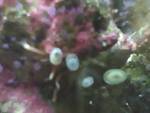 Full size pic Full size pic |
|
Re Baby snails...or something else?
Probably something else. 1/18/10
Thanks I know you tried your best. <You're very welcome.
If you want to send another photo of the critters in question, we
might be able to help out a bit more.> We took one out of the
tank to examine it better. It has a
hard cone shaped shell, some shells are black and some are tan.
The shell looks a little like a limpet like you said. <Limpets
are highly variable in nature. That's the best I could come
up with.> They have the 2 antennas that snails have and I can
see their mouths grazing the glass just like my Astrea snails.
Are all these common features of the limpets as well?
<Limpets do have antennae. I don't know too much about
them other than what they look like, unfortunately. Based on your
mouth and antenna description baby Stomatella snails are another
possibility. Do enquire via
a Google image search.> Sorry I couldn't get a better
picture. <Try, try again. Even out of the water might be
insightful.> Thanks at least I know they are safe and wont
harm anything. <Welcome. Matthew.>
|
|
Snail ID? - Good Picture for Archive?
1/17/10
Hi,
<Howdy>
Thought this would be a good picture for the snail identification
section. I wasn't sure what it was myself... I looked through
the Marine Snail ID section, but saw no picture like it. It was a
pretty striking pattern - appears to be a hitchhiker from within
the Zoanthids. It is about ½" to
¾" across.
Any ideas on what type it is?
<Mmm, yes. Appears to be a Heliacus species... I'd be
reading re. Bob Fenner>
Jon Hoover
|
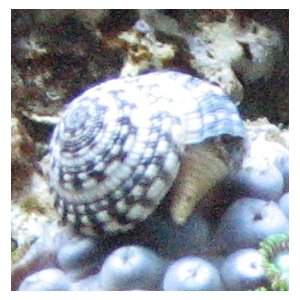 |
Re: Snail ID? - Good Picture for
Archive? 1/17/10
Hmmm... Upon review, it does have the cone shaped operculum which
is apparently a distinguishing characteristic of the Heliacus sp.
It's an interesting looking snail, but I like my Zoanthids more
than I like it.
Thanks!
Jon
<Welcome Jon. BobF> |
|
Small Snail ID in Reef Tank: Collonista Snails --
1/8/10
Hello crew!
<Hello Jon, Lynn here this evening!>
I have a 125 gallon reef setup I've written in about before a
couple of times (thank you for the help on those once again).
<On behalf of Bob and the crew, you're very
welcome.>
I've noticed over the past 2 or 3 months a lot of small
(1/8" to 1/4") snails. I would say there are probably
200 of them in the tank, and that could be a low count. They are
mainly found on the live rock and the glass (the side and back
glass mostly,
<That's pretty typical for these snails.>
..which don't get cleaned as often as the front and probably
have more food on them).
<Exactly>
They are nocturnal, hidden during the day.
<Yep>
Their small size makes them difficult to photograph, but the
attached photos are my best attempt.
<Thanks>
Any ideas what type they might be?
<Yes, they appear to be a very common harmless/beneficial
snail in the genus Collonista, also known as 'Mini Turbo'
snails. These mostly nocturnal snails range in size from about
1/8' to 1/4' across and vary in color and pattern from
solid white to combinations of white with tan, brown, or even
pink markings. If you'd like to positively confirm the ID,
remove one of the snails and (using a magnifying glass) look for
a hole/pit in the center of the operculum (the 'trap
door' in the opening of the snail). For more information and
photos, please see the following links. Several FAQ's at the
first link re: http://www.wetwebmedia.com/snailidf14.htm
http://bb.wetwebmedia.com/viewtopic.php?f=25&t=242 >
They don't seem to cause any problems for the coral, other
inverts or fish,
<Nope, they're harmless herbivores.>
..but there sure are a lot of them.
<It happens. The population tends to wax and wane according to
the amount of available food. There have been occasional reports
of overpopulations leading to problems with equipment (getting
stuck within intakes and such) but I've had zillions of these
guys in my tanks for years with no problems. I can't say the
same for some other larger snails I've had! At any rate, if
you feel like you have too many, you can always opt for physical
removal. Perhaps you could give the surplus individuals to a
fellow hobbyist. They really are terrific little snails!>
I figure I probably am feeding something too much, helping their
population numbers.
<Not necessarily. They're more than likely just taking
advantage of those areas you can't reach with an algae
scraper and doing a little clean up for you. That's usually
where mine tend to congregate. As far as they're concerned,
it's the equivalent of a Las Vegas style all-night,
all-you-can-eat buffet and everyone's been comped!>
I could probably cut back on my feeding, but all of those things
dying in the tank doesn't sound all that great either...
<No kidding. As long as everything's doing well in the
tank and your water parameters are okay, I wouldn't change a
thing. Just think of the Collonistas as part of the nightly
cleaning crew!>
It's an interesting nightly event...
<Yes indeed!>
Thanks in advance,
<You're very welcome.>
Jon Hoover
<Take care, LynnZ>
|
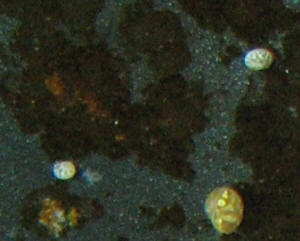 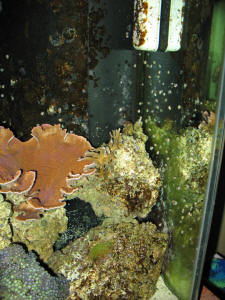
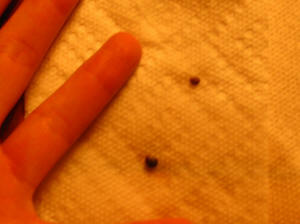 |
|
Snails: Likely Collonista Snails, Issues with
Disappearing Zoanthids -- 1/6/10
<Hello Tommy, Lynn here today.>
Help, I'm trying to ID this snail.
<Yay, I love snail ID's!>
I'm hoping it's not a Heliacus.
<I think you're in the clear. It looks like a common,
harmless, herbivorous hitchhiker in the genus Collonista,
sometimes called a 'Mini Turbo' snail. To positively
confirm, use a magnifying glass and take a good look at the
snail's operculum (the 'trap door' at the opening of
the snail). You should see a tiny pit/hole in the center. If you
don't see one, do try to get a few detailed photos and
we'll try again. Just for comparison, Heliacus spp. (aka
'Sundial') snails tend to be rather squat top to bottom,
with straighter sides, a rather heavy, almost 'beaded'
appearance to the surface, and an obvious cone-shaped operculum.
For more information/photos re: Collonista snails, please see the
related FAQ's at the following link:
http://www.wetwebmedia.com/snailidf14.htm
More here:
http://bb.wetwebmedia.com/viewtopic.php?f=25&t=242
Here's an example of Heliacus spp. snails:
http://www.gastropods.com/5/Shell_5765.shtml >
My zoo's are disappearing fast
<Uh-oh. If the water parameters/conditions and other livestock
are okay, then I'd look for either some sort of predator or
irritator, or evidence of disease. The list of potential
predators and irritators is long and includes Heliacus snails,
Pycnogonid spiders ('sea spiders'), Gammaridean
Amphipods, Vermetid Gastropods, Nudibranchs, a few crabs, various
fishes (Angels, Tangs etc.), tube dwelling Polychaetes, etc.(see
links below for photos). Your best chance of spotting some of the
smaller, and/or more cryptic individuals is at night with a
flashlight. If you're able to rule out pests, I'd look
into possible disease (pox, fungus, etc.). Take a good look at
the colony, especially the stems. Are there any light or whitish
spots present? Do the stems look fuzzy, spindly or unusually
dark? Once you determine what the problem is, please use our
Google search engine for a solution/treatment:
http://www.wetwebmedia.com/Googlesearch.htm
In the meantime, we have lots of information regarding Zoanthid
problems, starting here:
http://www.wetwebmedia.com/zoanthidhlthfaqs.htm
Check out this link for some terrific photos of Zoanthid
predators, irritators and pox:
http://zoaid.com/index.php?module=Gallery2&g2_itemId=384
>
..and I'm noticing that these snails are multiplying very
fast.
<Collonista snails can indeed multiply quickly, but don't
usually cause problems.>
These are the best pictures I could get.
<I think we're good to go with this snail. However, as per
above, if you find that what you have isn't a Collonista,
then do please let me know.>
Thanks for the help!
<You're very welcome!>
Tommy
<Take care, LynnZ>
~^~^~^~^~^~^~^~^~
| <°)))>< <°)))><
| <°)))>< <°)))><
¸¸.·´¯`·..
><((((º>`·.¸¸.·´
><((((º>`·.¸¸.·´¯`·.¸.·´¯`·...¸><((((º>¸¸.·´¯`·.¸.
`·..
><((((º>`·.¸¸.·´¯`·.¸><((((º>¸¸.·´¯`·.¸<°)))><
.¯`·.¸><((((º>
|
|
¿ >°)))><
|
  |
|
Re: Snails: Likely Collonista Snails, Issues with
Disappearing Zoanthids -- 1/7/10
<Hello Tommy, Lynn here again.>
Thanks for all of the help!
<You're welcome!>
I think it must be the asthenia snails
<You mean Asterina stars?>
..doing the damage. I guess I will get a harlequin shrimp to
combat these.
<I wouldn't, unless you're absolutely overrun with the
little stars. Otherwise, once they exhaust the food supply (of
stars), they'll likely starve to death. I would instead opt
for physical removal (tweezers work well). Please see the
following links for more info re:
http://www.wetwebmedia.com/harlshrpfaqs.htm
http://www.wetwebmedia.com/asterinafaqs.htm >
I will have to get rid of my sand star first though.
<It's possible that the star could escape the shrimp under
the sand, but I wouldn't chance it.>
I have attached a couple of pictures one is before and then you
can see what happened. The other is what the fire and ice look
like and it used to be full.
<Yikes!>
Again Thanks for the help!
<It was a pleasure! Take care, LynnZ>
|
|
|

